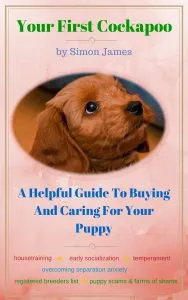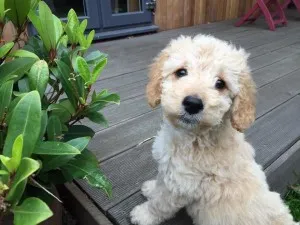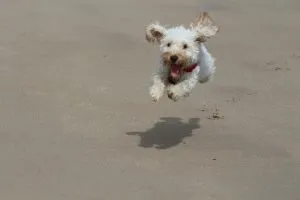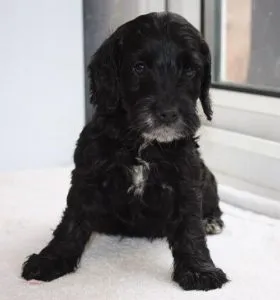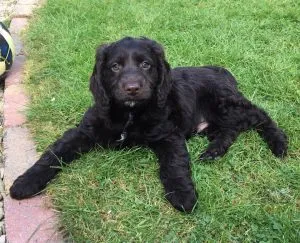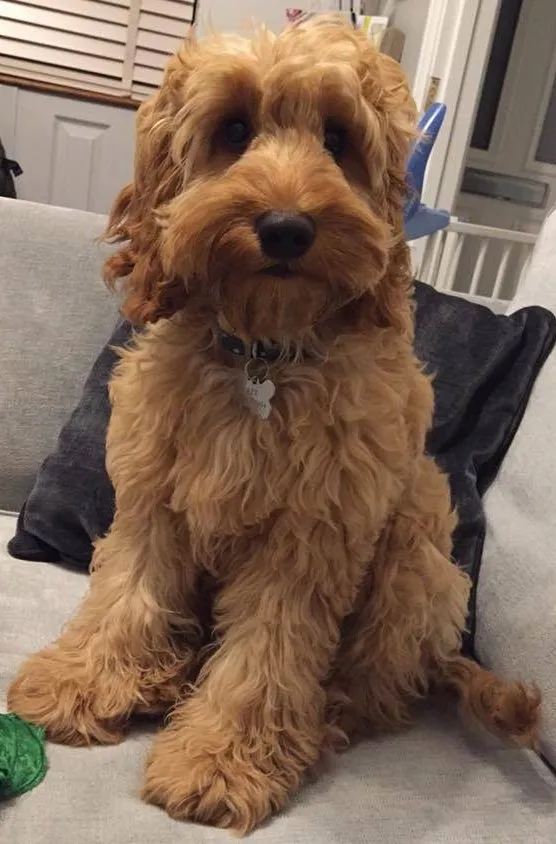Cockapoo v Cavapoo – can you tell the difference?
A lot of serious thinking goes into choosing a dog breed, but when dog breeds are similar it can be hard to make a final decision.
I’ve highlighted some key points of difference when choosing between a Cockapoo or Cavapoo, although similarities are abundant.
Why are they so similar?
The poo stands for Poodle. But there is a real difference here. The Cavapoo is bred from a Toy or Miniature Poodle. This means the full grown Cavapoo size is only ever going to be a small dog.
What is the difference in size?
The Cavapoo has two sizes:
- Miniature 13 – 17 ½ inches 12 – 18 lbs.
- Toy 11 – 14 inches 7 – 12lbs
The Cockapoo is also bred from a Standard Poodle so they can be much larger:
- Standard 15 -18 inches up to 19 lbs.
- Miniature 11-14 inches 13-18 lbs.
- Toy 9- 10 inches and weigh up to 12 lbs.
- Teacup less than 10 inches and average less than 6 lbs.

Why are they so popular?
The Cavapoo & Cockapoo became popular through crossbreeding programs in Australia. Breeders were experimenting to find the ideal family-friendly pet and defined the three qualities they most wanted as:
- A good temperament
- A dog that doesn’t shed too much hair (for allergy reasons)
- Having a good canine intelligence (to make a trainable dog)
The Other Half Of The Breed
The Cavalier King Charles Spaniel is exclusively used as a breeding partner for the Cavapoo. The CKC Spaniel is small and suitable to be bred with a Miniature or Toy Poodle (note: dogs of a similar size can only be bred together).
The breeding partner for the Cockapoo varies. It can be either an American or English Cocker Spaniel of the ‘working’ or ‘show’ variety. A Cockapoo bred from ‘working’ stock will have a lot more energy. If you’re looking for a lap-dog suitable for apartment style living, make sure your Cockapoo is bred from a ‘Show’ Cocker Spaniel.
Appearance
Both are adorable so it’s all a matter of opinion and taste which colour you are personally interested in. A Cavapoo has larger eyes than the Cockapoo; this comes from the Kind Charles look. It also has longer floppy ears.
Some Cockapoos and Cavapoos can have a distinctly Poodle look. Sometimes a puppy is bred back to a parent breed to exaggerate a characteristic. Often to put more curl in the coat.
Other Cockapoos can have a straight ‘flat’ coat which they inherit from the Cocker side of the gene pool.
Both breeds can come in two toned, tri colours or solid colours. People often feel drawn to a particular colour. For example, some people are fanatical about black Cockapoos!
Allergies and shedding
As mentioned above, Australian breeding programs intentionally selected The Poodle parent to breed a low shedding dog. But that doesn’t ensure a non-shedding or hypoallergenic dog.
Temperament
Both breeds are naturally disposed to have a good temperament. There are no origins of a fighting dog here. But every dog’s adult temperament depends on how well they are socialised and how their owner treats their dog. Problems can arise with any dog (just like humans). But if a dog is raised well, treated with respect and bad behaviour corrected with love not hard discipline, a well-rounded temperament develops.
Exercise and Training
All dogs love exercise. It’s simply the best thing you can do for your dog. The point worth making in this discussion though is a Cavapoo and the smaller Cockapoos are lap dogs. They can get by with one good walk / play a day. The Standard Cockapoo will benefit from more exercise, especially if bred from ‘working’ stock. They were bred for outdoor life so don’t commit to this type of Cockapoo unless you are an active outdoors’ person.
Separation anxiety
Dogs that are bred as companion dogs will suffer from separation anxiety more than other dogs. The Miniature and Toy sizes can be needy. But there are strategies you can use to help.
It’s also worth remembering that all dogs are pack animals. They are very relational and need company. If you don’t have much time to spend with your dog don’t get one!
Known Disorders
Just because certain dog breeds have known disorders doesn’t mean they will develop congenital health issues. Researching and selecting a good breeder who can evidence screening for health issues pre-breeding will increase the chance dramatically of your puppy living a long, healthy life.
But you should know, King Charles Cavalier Spaniels are known for heart disorders, so as long as the King Charles Cavalier Mum has her heart tested by a vet this weakness will not be passed on to the puppies.
For Cockapoos you should ensure PRA (Progressive Retinal Atrophy) clear after DNA test. And also, hip and elbow scores are high as hip dysplasia is common.
Puppies
Due to the popularity of Cavapoo and Cockapoo many dog breeders have entered the breeding business with the primary objective to make money. I have nothing against dog breeders earning a living, but like most businesses, profit maximisation often kicks in and this leads to cutting corners. By cutting corners I mean:
- Poor breeding environment
- The female or dam is over bred
- Lack of health testing, vaccinations and veterinary involvement
- Poor quality diet
- Not much socialisation
As well basic concerns for animal welfare it means your puppy will more likely be unhealthy, need expensive veterinary care and have a shortened life span. You can’t cut corners when choosing a puppy. I recommend reading my eBook on the subject.
Generations
F1 Cockapoo (F denotes the word Filial) this is the term used for the first crossing of a Standard Poodle with a Cocker Spaniel.
The generations are worked out by always adding one number up from the lowest number parent.
B is for backwards. For example (F1b). It’s quite common for a puppy to be bred back to a Parent breed dog, usually to improve the coat.
Do Cockapoos Cost More Than Cavapoos
They are about the same price. I checked out Raffles while writing this article as they breed both. I noted the price for two-tone colours are slightly more but for both breeds the price ranges from £995 – £1395.
Please read the puppy buying check list before you start your search.
Summary
Visually it’s often hard to tell the difference between a Cavapoo and a Cockapoo, but there are some major differences especially when considering your lifestyle and how much time you have to devote to exercise.
I’d love to know why you chose a Cavapoo or Cockapoo? Please post an answer below.
Research for this article
http://www.cockapoohq.com/cockapoo-vs-cavapoo-making-the-right-choice/
http://ilovemycockapoo.com/showthread.php?t=11357
https://www.bestcavapoos.com/
https://www.rafflescockapoos.co.uk/cavapoo-2
https://www.rspca.org.uk/adviceandwelfare/pets/dogs/puppy/cavalierkingcharlesspaniels


